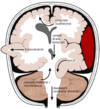General neurology stuff COPIED Flashcards
(49 cards)
Cycloplegia
paralysis of accommodation
dysarthria
slurred speech caused by articulation problems due to a motor deficit.
Dysphonia
loss of volume caused by laryngeal disorders.
Odynophagia
Pain on swallowing
Possible causes; infection, oesophageal cancer, larnynx or pharynx cancer.
Dysphagia
Difficulty swallowing
possible causes; pharyngitis, oesophageal disease
xerostomia
dry mouth
possible causes; anticholinergic drugs, Sjogren’s syndrome
Where’s the extradural space?
between the skull and the dura. Especially at the frontoparietal area. Other areas dura can be tightly bound to the skull.
cause: often tearing of middle meningeal artery.
Where’s the subdural space, and who’s vulnerable?
The elderly; tearing of the veins across the subdural space causing gradual seepage of blood
What is the main inhibitory neurotransmitter?
GABA (Gamma-Aminobutyric acid)
Papilloedema
Optic disc swelling; increased intracranial pressure.
Usually bilateral and can occur over a period of hours to weeks. Unilateral presentation is extremely rare.
May be asymptomatic or with a headache.
Ataxia
A term for a group of disorders that affect co-ordination, balance and speech.

A gumma is a soft, non-cancerous growth resulting from the tertiary stage of syphilis.
Gummas are most commonly found in the liver (gumma hepatis), but can also be found in brain, heart, skin, bone, testis, and other tissues.
paraparesis
partial paralysis of both legs.
(in contrast to paraplegia)

Polyneuropathy ; affects peripheral nerves
same areas on both sides of the body; featuring weakness, numbness, and burning pain.
It usually begins in the hands and feet and may progress to the arms and legs; May be caused by diabetes and Guillain–Barré syndrome.
Iris contraction/ pupil smaller
miosis
(pilocarpine causes this)

Extend the knee whilst the hip is in 90 degree flexion.
- positive if pain on extension. Sign is absent in local causes of neck stiffness.
NB> absence of this sign does not exclude meningitis.
Romberg’s sign
Can’t stand steadily with eyes closed.
motor speech area located on left hemisphere (dominant side)
Broca’s area
- comprehension okay, repetitive of words difficulty.
Area on dominant side involved with understanding language.
Symptoms of Wernicke’s aphasia are.. (30
Wernicke’s area
symptoms; profound word-finding difficulty,
impaired repetition of words
profound loss of comprehension
Lorazepam
IV only. Indicated for status epilepticus.
What are the initial symptoms of motor neurone disease?
In 2/3s, the first symptos occur in mthe arm or leg. This is sometimes called limb-onset disease. These symptoms include:
a weakened grip, which can cause difficulties picking up or holding objects
weakness at the shoulder, making lifting the arm above the head difficult
tripping up over a foot because of weakness at the ankle or hip
May be accompanied by widespread twitching of the muscles (fasciculations) or muscle cramps, and there may be visible wasting of the muscles with significant weight loss.
Bulbar-onset disease
1/4 of px, problems initially affect the muscles used for speech and swallowing. Increasingly slurred speech (dysarthria) is usually the first sign of this type of motor neurone disease, and may be misdiagnosed as a stroke.
As the condition progresses, it may become increasingly difficult to swallow (dysphagia), and be misdiagnosed as a blockage in the throat.
Huntington’s - bare facts
- inherited autosomal dominant disorder
- hyperkinetic movements. Mean age of 40.
- characterised by rapid, uncontrolled, flicking movements of the torso and limbs (chorea)
What is the diagnosis of concussion?
Diagnosis requires less than 30 minutes of loss of consciousness, memory loss of less than 24 hours, and a GCS score of 13 to 15.
Signs and symptoms of concussion
mild traumatic brain injury (mTBI)
a headache that doesn’t go away or isn’t relieved with painkillers
dizziness
feeling sick or vomiting
feeling stunned, dazed or confused
memory loss – you may not remember what happened before or after the injury
clumsiness or trouble with balance
unusual behaviour – you may become irritated easily or have sudden mood swings
changes in your vision – such as blurred vision, double vision or “seeing stars”
being knocked out or struggling to stay awake




